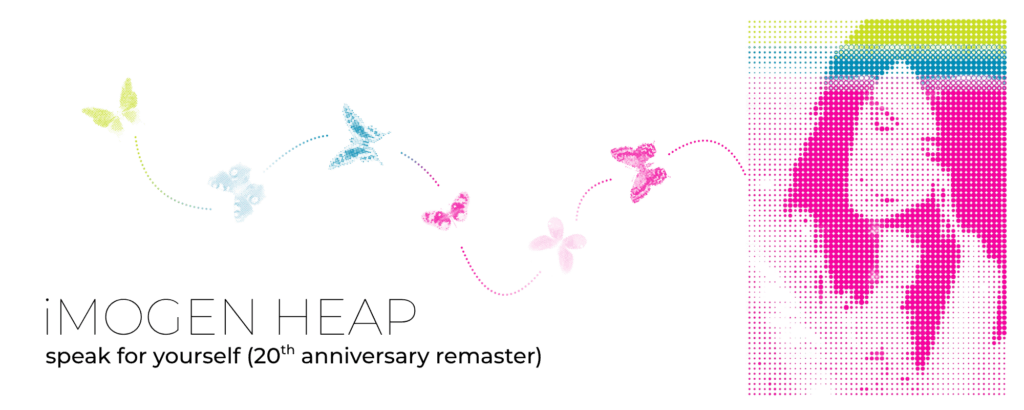Speak For Yourself (20th Anniversary Remaster) Review

Design by Christian Jones
By Bryannah Basil
Suppose you ask any Imogen Heap fan how they first encountered her. In that case, you’ll most likely hear one out of a slew of options: she’s one half of Frou Frou with Guy Sigsworth, her song “Hide and Seek” was featured in an episode of The OC and was sampled by Jason Derulo in 2009’s “Whatcha Say,” or that she’s been sampled by various rappers ranging from A$AP Rocky (“I Smoked Away My Brain”) to Kendrick Lamar (“Textbook Stuff”).
I encountered her through Shrek. Shrek 2, to be more exact. At the end of the movie, after hearing Jennifer Saunders’ powerful cover of Bonnie Tyler’s “Holding Out For Hero,” while the ending credits roll, Frou Frou’s dark and stormy cover of the same song plays. I was enthralled, so much that I nearly broke the old VHS tape I was watching it on with how many times I rewinded it to hear the song again, daydreaming about a larger-than-life hero waiting to sweep me off my feet.
It wouldn’t be until a decade later that I’d properly familiarize myself with Heap. It was 2022 and Frou Frou had dropped Off Cuts, an EP of demos left off their 2002 album Details in commemoration of its 20th anniversary. Off Cuts included “A New Kind of Love,” which had gone viral on TikTok, and I was obsessed. It was this song that led me to listen to anything Imogen Heap touched, including 2005’s pivotal Speak for Yourself. Thus, when Heap announced the album was getting remastered to celebrate 20 years, it was a no-brainer to tune in for a work so near and dear to my heart.
Fresh off the acclaim for Details, Imogen Heap wanted to test her hand at self-producing and make a bid for full artistic control, and hence, she embarked on what would become Speak for Yourself. This remastered version adds a layer of polish and sheen like any standard remaster, but for Heap, it enhances the soundscape and reveals delightful surprises for listeners new and old.
The album’s opener, “Headlock,” was initially released as the final single and went relatively under the radar until last year, when edits of the video game Mouthwashing popularized the song on TikTok and Instagram. Funky synths that were previously muddled, emerge in full clarity on the remaster, while the listener is swept up in powerful whooshes and Imogen’s harmonies that build and swell over. As the song closes and transitions into “Goodnight and Go,” Heap whispers the lyric, “How can you lose?”. It’s a gentle reminder that in the midst of self-doubt, you have the power to get out of your own headlock.
On “Goodnight and Go,” bewitching synths encapsulate the wooziness of falling in love. They are perfectly complimented by sharp drums that command your attention, as Heap seemingly sings about a guiltless crush. Though, as the song delightfully creeps towards the end, the strings during the bridge come to life, in tandem with the realization that the nature of Heap’s crush is more obsessive than innocent, all underscored by the moody guitar.
Heap’s descent into darker, more uncertain emotions continues in “Have You Got It in You?” as she talks about perseverance during intense moments, where she has anything but that. The remaster accentuates its lyrical content and Heap’s vocal performance with grounding lyrics like “Been one of those days/ Safety first, don’t push/ What’s the hurry?” Heap settles on taking things slow and safe — a stark contrast to the gloomy, atmospheric instrumental that looms over the song.
She swims up for air on “Loose Ends,” a noticeably lighter song in comparison to its predecessor. The sharper and more snappy drums not only return for this song, but give you a sweet treat as they gallop throughout the rest of the album, a feat that only a remaster could achieve. The remaster for this song not only revitalizes the buzzy synthesizer that’s a little blurred in the older version, but shines a light on Heap’s backing harmonies, as she contemplates the loose ends of a monotonous relationship. As she sings “It’s complicated/This time I think it could be/Triangulated/It could be just what we need/So what you say we give it up and walk away?/Nothing to salvage anyway,” you can finally make out Heap’s dull “Ahhs” in the back, as if she, too, is flippantly accepting the end of the relationship.
Following “Loose Ends” is what is acclaimed as Heap’s best song by fans and critics alike: “Hide and Seek.” On this track, which has some of the best mixing work on this edition, Heap simply uses her voice and a vocoder to talk about her parents’ divorce when she was a child. The new inclusion of Heap’s inhales and better emphasized moments of silence adds a new layer of poignancy to the song, in addition to the main and backing vocals being more distinguished from each other. As the song fades out, one can hear carousel-like bells tolling in the back, as if symbolizing the end of Heap’s childhood and happiness. Though, these bells take on a jovial sound in “Clear the Area,” the first song written for the album.
In “Daylight Robbery,” a song originally written for an advertising agency, you are subjected to a maelstrom of punchy synths, abrasive guitar, and backing vocals that are nothing short of wizardry, before being harshly dropped in the soundscape of “The Walk.” “The Walk” harkens back to Heap’s I Megaphone days through an aggressive guitar bridge and rumbling beats that ebb and flow, while Heap sings about her personal hedgehog dilemma.
In the final stretch of the album, the remaster gives a facelift to most of the songs, but is nothing to write home about outside of “Closing In,” the penultimate track where Heap zealously awaits union with a lover. This song undoubtedly has the best EQ improvement on the album, as the instruments don’t drown out Heap’s vocals and take a backseat to let what she’s saying take front and center (especially during the outro)—a clear difference from the original. In all, Speak for Yourself highlights why Heap’s work continues to resonate and inspire twenty years later. This remaster doesn’t reinvent the album, but varnishes the intricate production and lush sounds that made it so unique in the first place, with each track feeling like it’s been leased a new life. Whether you’re revisiting an old favorite, or tuning in for the first time, this remaster demonstrates why the album was (and still is) ahead of its time, and truly speaks for itself (pun intended).
